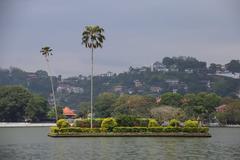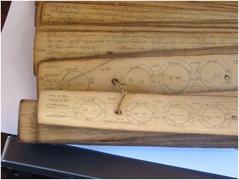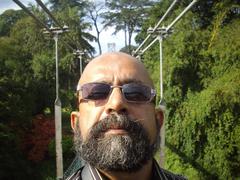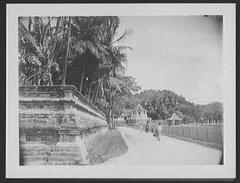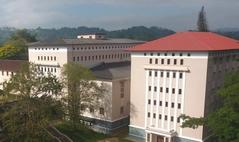Udawatta Kele Sanctuary: Visiting Hours, Tickets, and Comprehensive Travel Guide
Date: 04/07/2025
Introduction: Discovering Kandy’s Royal Forest
Nestled atop a verdant ridge overlooking the historic city of Kandy, Sri Lanka, Udawatta Kele Sanctuary—known as the “Royal Forest Park of Kandy”—is a living testament to the harmonious blend of nature, history, and spirituality. Spanning 104 hectares, this sanctuary is celebrated for its thriving biodiversity, ancient Buddhist hermitages, and deep-rooted royal heritage. As an urban green lung, it plays a crucial ecological role, stabilizing slopes, filtering air, and serving as a haven for endemic species. Whether you’re a nature enthusiast, cultural explorer, or spiritual seeker, Udawatta Kele offers a unique experience in the heart of Kandy. This guide presents essential visitor details, including updated visiting hours, ticket information, directions, ecological highlights, and cultural insights to ensure a rewarding visit. (Sri Lanka Travel Pages, Ceylon Pulse, Travel Map Sri Lanka)
Contents
- Introduction
- Visiting Hours and Ticket Information
- How to Get There
- Ecology and Biodiversity
- Cultural and Historical Significance
- Sanctuary Trails and Exploration
- Wildlife and Birdwatching
- Conservation and Responsible Tourism
- Visitor Facilities and Accessibility
- Nearby Attractions
- Activities and Experiences
- FAQs
- Summary and Visitor Recommendations
- Sources
Visiting Hours and Ticket Information
Opening Hours:
Udawatta Kele Sanctuary is open every day from 6:00 AM to 6:00 PM, providing visitors with generous daylight hours to explore trails and historic sites.
Entry Fees (2024):
- Sri Lankan Nationals: LKR 100–300
- Foreign Visitors: LKR 570–1,000 (approx. USD 2–3)
- Children and group rates: Available upon inquiry
Tickets are sold at the sanctuary entrance and may also be available through official online portals. Carry cash in LKR for convenience. (Travel Triangle)
Best Time to Visit:
December to April is the ideal season, with drier weather and vibrant wildlife activity, especially for birdwatchers.
How to Get There
Udawatta Kele Sanctuary is located about 2 km from central Kandy, easily reachable by tuk-tuk, taxi, or even on foot. Public buses serving Kandy stop near the main entrance, which is situated on Sangamitta Mawatha, close to Royal Palace Park. Parking is available for private vehicles. Kandy itself is well connected to Colombo and other major cities by rail and road, making the sanctuary accessible for day trips or longer stays. (Travel Map Sri Lanka)
Ecology and Biodiversity
Flora Diversity
The sanctuary’s 104 hectares encompass a multi-layered forest ecosystem. Visitors can expect to encounter towering jak trees, giant ferns, lianas, epiphytes, and rare orchids. The undergrowth is rich in mosses, shrubs, and a variety of small trees, providing vital habitats for decomposers and supporting nutrient cycling. Notably, the “Pus Wela” liana, estimated to be 200–300 years old, is a botanical highlight. (Thingstodoinasia)
Faunal Richness
Udawatta Kele is a hotspot for wildlife, harboring more than 80 bird species, including endemics such as Layard’s parakeet and the Sri Lanka hill myna. Birdwatching is especially rewarding from December to April, with sightings of kingfishers, eagles, brown-capped babblers, and black-capped bulbuls. The sanctuary also supports mammals like the purple-faced langur, toque macaque, wild boar, porcupines, and a variety of reptiles and butterflies. (Visit Sri Lankan)
Ecological Functions
As an urban forest, Udawatta Kele regulates Kandy’s microclimate, intercepts rainfall to prevent soil erosion and landslides, and acts as a carbon sink to mitigate air pollution. The sanctuary’s role in regional green corridors supports species migration and genetic diversity. (TravelSetu)
Cultural and Historical Significance
Royal and Spiritual Legacy
Once called “Uda Wasala Watta” or “the garden above the royal palace,” the sanctuary was historically preserved for Kandyan royalty and Buddhist monks. Its proximity to the Temple of the Sacred Tooth Relic (Sri Dalada Maligawa) underscores its cultural importance. Ancient pathways, royal ponds, and meditation hermitages still exist, embodying the sanctuary’s role as a refuge for spiritual practice and royal retreat. (Ceylon Pulse)
Symbolism and Sacred Ecology
Udawatta Kele is revered as a symbol of renewal, spiritual harmony, and ecological stewardship. Forest conservation here is recognized as both a cultural and spiritual duty, with community-led tree-planting ceremonies and religious processions during festivals like Vesak and Poson.
Sanctuary Trails and Exploration
Visitors can explore an extensive network of well-marked trails:
- Main Trail: Easy access to core forest areas, suitable for most visitors
- Pond Trail: Leads to tranquil ponds ideal for wildlife observation
- Kodimale Peak Trail: A moderate ascent offering panoramic views of Kandy
- Hermitage and Cave Trails: Paths to ancient meditation caves and Buddhist hermitages, including the famed Senkanda Cave (Kandy City)
Trail maps are available at the visitor center. Wear sturdy footwear as some paths may be slippery after rain.
Wildlife and Birdwatching
Early mornings (6:00–9:00 AM) are prime for wildlife activity. Birdwatchers can spot numerous endemics, while patient visitors might see monkeys, squirrels, and—rarely—elusive mammals like wild boar or even leopards. Reptiles, butterflies, and amphibians are also abundant. (Sri Lankan Guide)
Conservation and Responsible Tourism
Managed by the Sri Lanka Forest Department, the sanctuary emphasizes:
- Protection of native flora and fauna
- Reforestation and habitat restoration
- Environmental education through the onsite Nature Education Centre
Visitors are expected to stay on marked trails, avoid littering, refrain from feeding wildlife, and respect all spiritual sites. (Wonders of Ceylon)
Visitor Facilities and Accessibility
- Visitor Center: Offers maps, guided tour bookings, and information
- Rest Areas: Benches and picnic spots along main trails
- Restrooms: Available near the entrance
- Food and Water: No cafeteria; bring your own supplies and carry out all trash
Some main trails are relatively accessible, but the terrain can be uneven. Visitors with mobility challenges should consult the visitor center for assistance.
Nearby Attractions
Udawatta Kele’s central location allows easy access to Kandy’s top cultural and natural attractions:
- Temple of the Sacred Tooth Relic
- Kandy Lake
- Royal Palace of Kandy
- Peradeniya Botanical Gardens
- Ceylon Tea Museum
- Pinnawala Elephant Orphanage
These sites can be visited by tuk-tuk, taxi, or public transport.
Activities and Experiences
- Hiking and Nature Walks: Trails for all fitness levels with interpretive guided walks available
- Birdwatching and Photography: Early mornings and late afternoons are optimal
- Meditation and Spiritual Retreat: Hermitages and caves provide tranquil settings
- Picnicking: Designated areas available; maintain cleanliness and respect wildlife
Frequently Asked Questions (FAQ)
Q: What are Udawatta Kele Sanctuary’s visiting hours?
A: Daily from 6:00 AM to 6:00 PM.
Q: How much is the entrance fee?
A: LKR 100–300 for Sri Lankans, LKR 570–1,000 for foreigners, with possible group rates.
Q: Are guided tours available?
A: Yes, arrange at the visitor center or via local operators.
Q: Is the sanctuary accessible for wheelchairs?
A: Accessibility is limited; some main trails may be manageable, but visitors with mobility needs should inquire in advance.
Q: When is the best time to visit?
A: December to April, especially in the early morning.
Q: What safety tips should I follow?
A: Wear sturdy shoes, carry water, stay on trails, and avoid feeding animals.
Summary and Visitor Recommendations
Udawatta Kele Sanctuary offers a unique intersection of Sri Lanka’s biodiversity, royal history, and Buddhist spirituality. Its well-maintained trails, diverse wildlife, and revered hermitages provide enriching experiences for every visitor. The sanctuary’s ecological role in urban Kandy and its contribution to regional conservation networks highlight its ongoing importance.
To preserve this natural and cultural gem, visitors should follow guidelines on respectful behavior, dress, and environmental care. Plan your visit during the dry season, consider guided tours for deeper insights, and explore the rich array of nearby Kandy attractions for a comprehensive experience.
For updates, event information, and audio-guided tours, download the Audiala app and follow the sanctuary’s official channels.
Sources and Further Reading
- Sri Lanka Travel Pages
- Ceylon Pulse
- Thingstodoinasia
- TravelSetu
- Travel Map Sri Lanka
- Kandy City
- Travel Triangle
- Visit Sri Lankan
- UNESCO
- Wonders of Ceylon
For the most current details, visit the official Sri Lanka Tourism website and the official Kandy tourism portal.
Alt text: Udawatta Kele Sanctuary forest path with dense native flora
